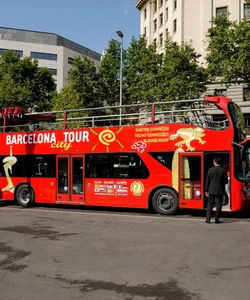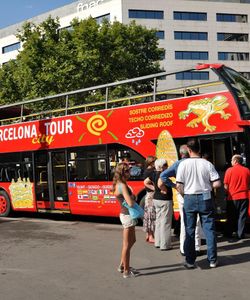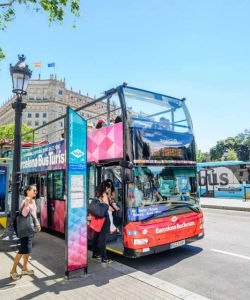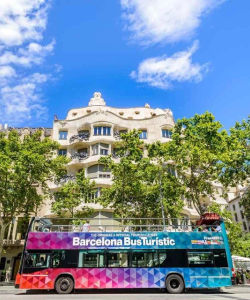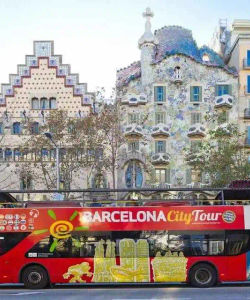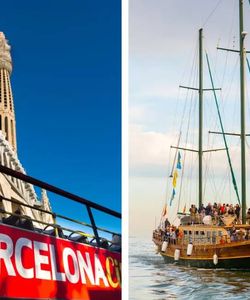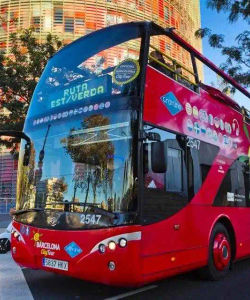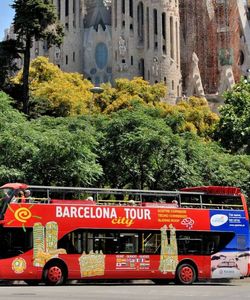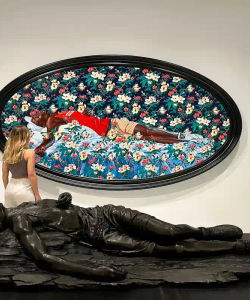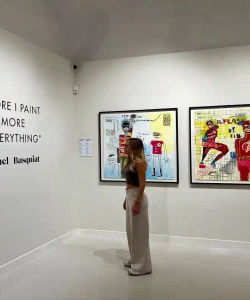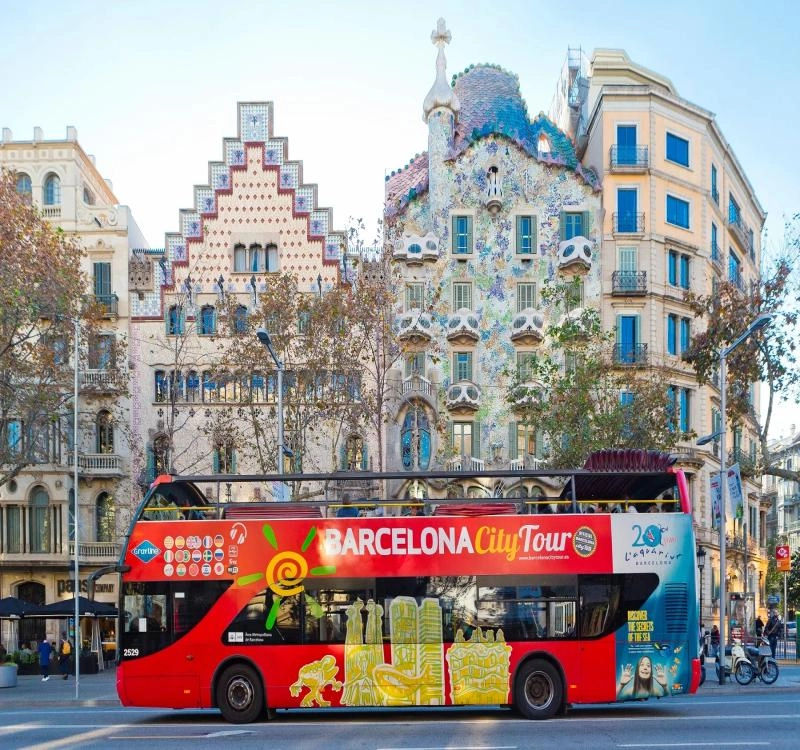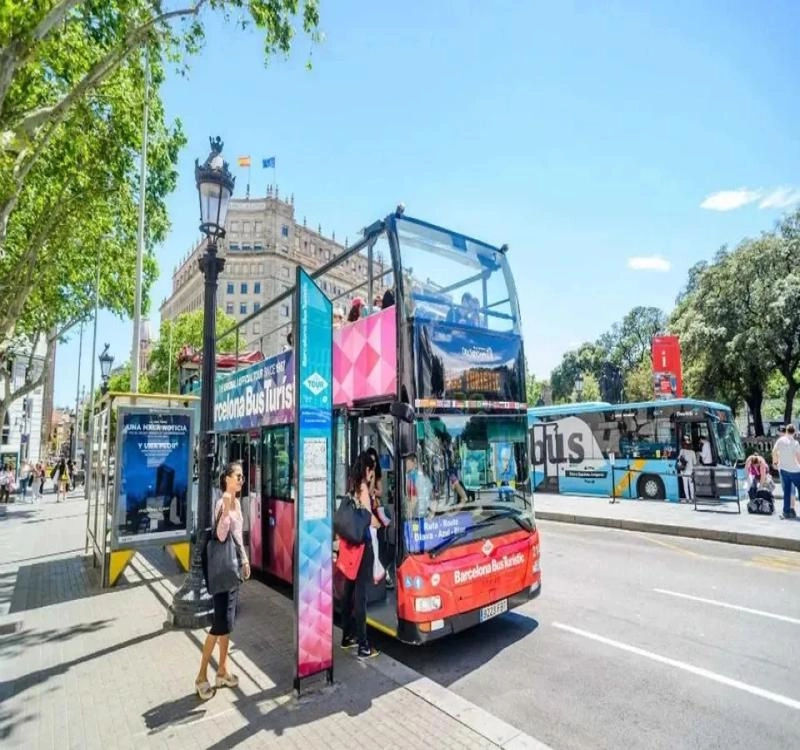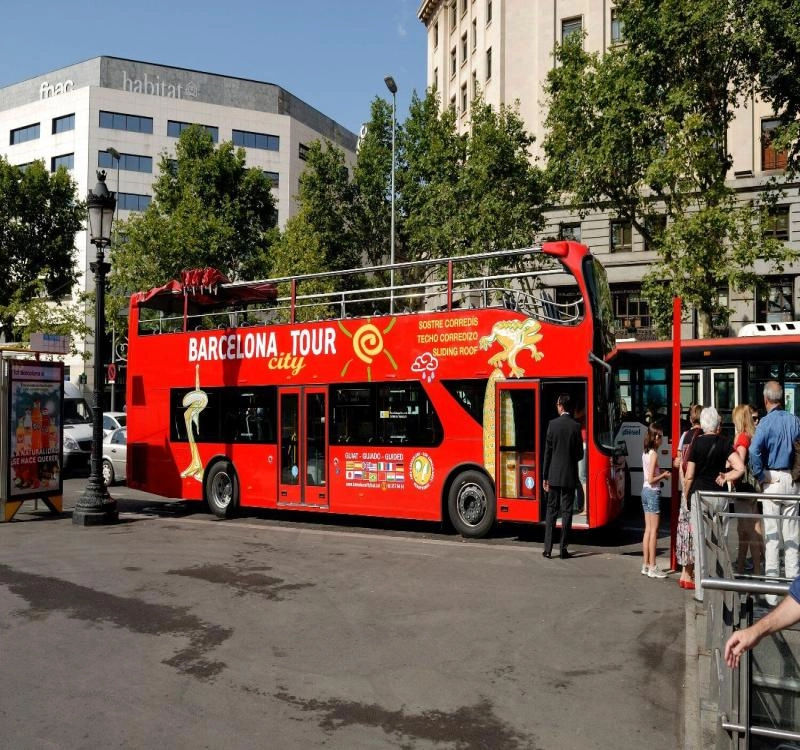Hop On Hop Off Barcelona Bus Tours
Barcelona City Tour: Hop-On, Hop-Off Bus Tour
- Barcelona Hop-on, Hop-off tour gives you freedom to plan your Barcelona Sightseeing itinerary
- 2 routes and over 30 stops cover all the Barcelona top attractions
- Pre-recorded audio commentary available in 15 languages
- FREE Wi-Fi on board
- Free Discount voucher booklet
- Smartphone Voucher Accepted! (No need to print)
- Barcelona Hop-on, Hop-off tour gives you freedom to plan your Barcelona Sightseeing itinerary
- 2 routes and over 30 stops cover all the Barcelona top attractions
- Pre-recorded audio commentary available in 15 languages
- FREE Wi-Fi on board
- Free Discount voucher booklet
- Smartphone Voucher Accepted! (No need to print)
- 24 or 48-Hours Barcelona Hop-On, Hop-Off Bus Ticket
- Audio Guide in 15 languages (Spanish, Catalan, English, German, French, Italian, Dutch, Chinese, Japanese, Portuguese, Hindi, Russian, Swedish, Arabic and Hebrew)
- Free Wi-Fi on-board
- Map and Guide
- Discount coupon booklet
- 24 or 48-Hours Barcelona Hop-On, Hop-Off Bus Ticket
- Audio Guide in 15 languages (Spanish, Catalan, English, German, French, Italian, Dutch, Chinese, Japanese, Portuguese, Hindi, Russian, Swedish, Arabic and Hebrew)
- Free Wi-Fi on-board
- Map and Guide
- Discount coupon booklet
No Cancellation Charges up to 24 hours before the chosen travel date. 100% cancellation fee applied within 24 hours of travel date.
City Sightseeing: Barcelona Bus Turistic Hop-On, Hop-Off Bus
Tour
- Flexibility of 24/ 48-Hours tour available to enjoy the best sights of Barcelona
- With the high frequency of Buses, don’t worry about queues even in the peak season
- Specially formulated 2 bus routes across the city to provide the best experience.
- Internet all time on board with free WiFi services
- Tour designed explicitly with 16 languages audio guide
- Discount of up to 250€ to enjoy Barcelona at its best
- Both Printed/ Smartphone Voucher Accepted!
- Flexibility of 24/ 48-Hours tour available to enjoy the best sights of Barcelona
- With the high frequency of Buses, don’t worry about queues even in the peak season
- Specially formulated 2 bus routes across the city to provide the best experience.
- Internet all time on board with free WiFi services
- Tour designed explicitly with 16 languages audio guide
- Discount of up to 250€ to enjoy Barcelona at its best
- Both Printed/ Smartphone Voucher Accepted!
- 24/ 48-Hours Barcelona Hop-on Hop-off Bus Ticket
- Audio Guide in English, Spanish, French, German, Italian, Dutch, Hebrew, Japanese, Portuguese, Russian, Swedish, Arabic, Turkish, Catalan, Norwegian, Chinese
- Free Wi-Fi on-board
- Coupon booklet with more than 250 € benefits
- 24/ 48-Hours Barcelona Hop-on Hop-off Bus Ticket
- Audio Guide in English, Spanish, French, German, Italian, Dutch, Hebrew, Japanese, Portuguese, Russian, Swedish, Arabic, Turkish, Catalan, Norwegian, Chinese
- Free Wi-Fi on-board
- Coupon booklet with more than 250 € benefits
Red Route: Schedule: 09:00 - 19:00 Loop: 120 Minutes Frequency: 20-30 Minutes First Departure Point: Plaça de Catalunya
Blue Route: Schedule: 09:00 - 19:00 Loop: 120 Minutes Frequency: 20-30 Minutes First Departure Point: Plaça de Catalunya
Red Route: Schedule: 09:00 - 19:00 Loop: 120 Minutes Frequency: 20-30 Minutes First Departure Point: Plaça de Catalunya
Blue Route: Schedule: 09:00 - 19:00 Loop: 120 Minutes Frequency: 20-30 Minutes First Departure Point: Plaça de Catalunya
Wheelchair Access: Yes with Manual Ramp
Voucher Type: Both Mobile and Printed Voucher are accepted
Onboard Wi-Fi: Yes (Please ask bus staff for further details)
Pets Allowed: Small, well-behaved dogs are allowed (Dogs must be in a portable kennel)
Infants can travel free and you do not require to book infant ticket.
Multiday tickets can only be used on consecutive days.
Complimentary ear phones are provided, or you are welcome to use your own wired earphones with a jack connector
Tours operate in all weather, rain or shine. Refunds due to weather will not be granted unless the service is suspended as a result of weather.
Disclaimer: Due to traffic issues, public holidays, weather conditions, and unforeseen circumstances, there might be sudden changes in the route or on the schedule. Traffic congestion and road closures - may cause delays, reduced frequency and changes to the route. We’ll do all we can to provide a smooth and frequent service! No refund will be offered for any changes or cancelations due to any unforeseen circumstances.
Wheelchair Access: Yes with Manual Ramp
Voucher Type: Both Mobile and Printed Voucher are accepted
Onboard Wi-Fi: Yes (Please ask bus staff for further details)
Pets Allowed: Small, well-behaved dogs are allowed (Dogs must be in a portable kennel)
Infants can travel free and you do not require to book infant ticket.
Multiday tickets can only be used on consecutive days.
Complimentary ear phones are provided, or you are welcome to use your own wired earphones with a jack connector
Tours operate in all weather, rain or shine. Refunds due to weather will not be granted unless the service is suspended as a result of weather.
Disclaimer: Due to traffic issues, public holidays, weather conditions, and unforeseen circumstances, there might be sudden changes in the route or on the schedule. Traffic congestion and road closures - may cause delays, reduced frequency and changes to the route. We’ll do all we can to provide a smooth and frequent service! No refund will be offered for any changes or cancelations due to any unforeseen circumstances.
No Cancellation Charges up to 24 hours before the chosen travel date. 100% cancellation fee applied within 24 hours of travel date.
Barcelona City Tour Hop-On, Hop-Off + Spotify Camp Nou
Experience Museum
- On the West route, explore Barcelona's western icons, such as the FC Barcelona stadium and the National Museum of Art of Catalonia.
- On the East route, explore Barcelona's artistic side, with landmarks like Park Güell and the recognizable Sagrada Familia.
- Board and depart any time on one of our double-decker buses to explore the city at your own pace.
- Experience the new F.C. Barcelona museum, and learn about its past, present, & future.
- Discover the captivating "Spotify Camp Nou Live" performance, which offers a 360-degree immersive experience.
- Smartphone Voucher Accepted. (No need to print)
- On the West route, explore Barcelona's western icons, such as the FC Barcelona stadium and the National Museum of Art of Catalonia.
- On the East route, explore Barcelona's artistic side, with landmarks like Park Güell and the recognizable Sagrada Familia.
- Board and depart any time on one of our double-decker buses to explore the city at your own pace.
- Experience the new F.C. Barcelona museum, and learn about its past, present, & future.
- Discover the captivating "Spotify Camp Nou Live" performance, which offers a 360-degree immersive experience.
- Smartphone Voucher Accepted. (No need to print)
- 24/ 48-Hours Barcelona Hop-on Hop-off Bus Ticket (as per option chosen)
- Audio Guide in 15 languages (Spanish, Catalan, English, German, French, Italian, Dutch, Chinese, Japanese, Portuguese, Hindi, Russian, Swedish, Arabic and Hebrew)
- Admission to the Camp Nou Experience at FC Barcelona.
- Free Wi-Fi on-board
- Map and Guide
- Discount coupon booklet Audio Guide in the "Immersive tour" (mobile app)
- 24/ 48-Hours Barcelona Hop-on Hop-off Bus Ticket (as per option chosen)
- Audio Guide in 15 languages (Spanish, Catalan, English, German, French, Italian, Dutch, Chinese, Japanese, Portuguese, Hindi, Russian, Swedish, Arabic and Hebrew)
- Admission to the Camp Nou Experience at FC Barcelona.
- Free Wi-Fi on-board
- Map and Guide
- Discount coupon booklet Audio Guide in the "Immersive tour" (mobile app)
Smoking: Not allowed on board
Disclaimer: Due to traffic issues, public holidays, weather conditions, cruise ship arrivals and unforeseen circumstances, there might be sudden changes in the route or on the schedule. In "normal times" Barcelona is a busy city, especially during special events, summer holidays and at weekends. Traffic congestion and road closures - may cause delays, reduced frequency and changes to the route. We’ll do all we can to provide a smooth and frequent service!
Smoking: Not allowed on board
Disclaimer: Due to traffic issues, public holidays, weather conditions, cruise ship arrivals and unforeseen circumstances, there might be sudden changes in the route or on the schedule. In "normal times" Barcelona is a busy city, especially during special events, summer holidays and at weekends. Traffic congestion and road closures - may cause delays, reduced frequency and changes to the route. We’ll do all we can to provide a smooth and frequent service!
No Cancellation Charges up to 24 hours before the chosen travel date. 100% cancellation fee applied within 24 hours of travel date. Camp Nou Experience Ticket is Non-Refundable.
Barcelona City Tour: Hop-On, Hop-Off Bus Tour and Eco
Catamaran Cruise
- On a double-decker bus, you can see the city's highlights while relaxing and taking in the views.
- On a hop-on, hop-off sightseeing tour of Barcelona, you can set your own speed.
- Take a leisurely catamaran ride around Barcelona's shoreline.
- The Sagrada Familia, a Roman Catholic church, is one of the world's most famous structures.
- Take a stroll through Port Olmpic, the site of the 1992 Summer Olympics sailing competitions.
- Smartphone Voucher Accepted! (No need to print)
- On a double-decker bus, you can see the city's highlights while relaxing and taking in the views.
- On a hop-on, hop-off sightseeing tour of Barcelona, you can set your own speed.
- Take a leisurely catamaran ride around Barcelona's shoreline.
- The Sagrada Familia, a Roman Catholic church, is one of the world's most famous structures.
- Take a stroll through Port Olmpic, the site of the 1992 Summer Olympics sailing competitions.
- Smartphone Voucher Accepted! (No need to print)
- 24 / 48-Hours Barcelona Hop-on Hop-off Bus Ticket (as per option chosen)
- Audio Guide in 15 languages (Spanish, Catalan, English, German, French, Italian, Dutch, Chinese, Japanese, Portuguese, Hindi, Russian, Swedish, Arabic and Hebrew)
- Free Wi-Fi on-board
- 1-Hour Eco Catamaran Cruise tour along Barcelona coast (The crew speaks English and Spanish!)
- Map and Guide
- Discount coupon booklet
- 24 / 48-Hours Barcelona Hop-on Hop-off Bus Ticket (as per option chosen)
- Audio Guide in 15 languages (Spanish, Catalan, English, German, French, Italian, Dutch, Chinese, Japanese, Portuguese, Hindi, Russian, Swedish, Arabic and Hebrew)
- Free Wi-Fi on-board
- 1-Hour Eco Catamaran Cruise tour along Barcelona coast (The crew speaks English and Spanish!)
- Map and Guide
- Discount coupon booklet
Smoking: Not allowed on board
In case of Catamaran cruise cancellation due to meteorological causes, an alternative day will be offered to the client, if this is not possible, a partial amount of the reservation will be refunded.
Disclaimer: Due to traffic issues, public holidays, weather conditions, cruise ship arrivals and unforeseen circumstances, there might be sudden changes in the route or on the schedule. In "normal times" Barcelona is a busy city, especially during special events, summer holidays and at weekends. Traffic congestion and road closures - may cause delays, reduced frequency and changes to the route. We’ll do all we can to provide a smooth and frequent service!
Smoking: Not allowed on board
In case of Catamaran cruise cancellation due to meteorological causes, an alternative day will be offered to the client, if this is not possible, a partial amount of the reservation will be refunded.
Disclaimer: Due to traffic issues, public holidays, weather conditions, cruise ship arrivals and unforeseen circumstances, there might be sudden changes in the route or on the schedule. In "normal times" Barcelona is a busy city, especially during special events, summer holidays and at weekends. Traffic congestion and road closures - may cause delays, reduced frequency and changes to the route. We’ll do all we can to provide a smooth and frequent service!
No Cancellation Charges up to 24 hours before the chosen travel date. 100% cancellation fee applied within 24 hours of travel date or No-show.
Barcelona City Tour: Hop-On, Hop-Off and Premium Catamaran
Cruise
- Explore Barcelona by land and sea with the premium catamaran cruise combo.
- Audio guide available in multiple languages, including Catalan, Spanish, English, Dutch, Italian, Hindi, Chinese, Japanese, Swedish, Portuguese, Russian, German, Arabic, French, and Hebrew.
- West route allows you to visit attractions including the FC Barcelona stadium and National Museum of Art of Catalonia.
- East route takes you through the artistic side of the city, including the Sagrada Familia, Park Güell, and Plaça Catalunya.
- Enjoy a 90-minute catamaran cruise along the city coastline with a Mediterranean cocktail or local wine, accompanied by chill-out music.
- Smartphone Voucher Accepted! (No need to print)
- Explore Barcelona by land and sea with the premium catamaran cruise combo.
- Audio guide available in multiple languages, including Catalan, Spanish, English, Dutch, Italian, Hindi, Chinese, Japanese, Swedish, Portuguese, Russian, German, Arabic, French, and Hebrew.
- West route allows you to visit attractions including the FC Barcelona stadium and National Museum of Art of Catalonia.
- East route takes you through the artistic side of the city, including the Sagrada Familia, Park Güell, and Plaça Catalunya.
- Enjoy a 90-minute catamaran cruise along the city coastline with a Mediterranean cocktail or local wine, accompanied by chill-out music.
- Smartphone Voucher Accepted! (No need to print)
- 24 / 48-Hours Barcelona Hop-on Hop-off Bus Ticket
- Audio Guide in 15 languages (Spanish, Catalan, English, German, French, Italian, Dutch, Chinese, Japanese, Portuguese, Hindi, Russian, Swedish, Arabic and Hebrew)
- Free Wi-Fi on-board
- 90 Minutes Premium Catamaran Cruise tour along Barcelona Coast (including background chill-out music and free Wi-Fi)
- Map and Guide
- Discount Coupon Booklet
- 24 / 48-Hours Barcelona Hop-on Hop-off Bus Ticket
- Audio Guide in 15 languages (Spanish, Catalan, English, German, French, Italian, Dutch, Chinese, Japanese, Portuguese, Hindi, Russian, Swedish, Arabic and Hebrew)
- Free Wi-Fi on-board
- 90 Minutes Premium Catamaran Cruise tour along Barcelona Coast (including background chill-out music and free Wi-Fi)
- Map and Guide
- Discount Coupon Booklet
Catamaran: Ticket can be used at any of the Day time departures detailed below: 01 April - 14 May: 11:15 am / 1:15 pm / 3:15 pm / 5:15 pm 15 May - 15 June: 11:45 am / 1:45 pm / 3:45 pm / 5:45 pm 16 June - 31 July: 11:45 am / 1:45 pm / 3:45 pm 01 - 31 August: 11:15 am / 1:15 pm / 3:15 pm 01 - 17 September: 10:45 am / 12:45 pm / 2:45 pm / 4:45 pm 18 - 30 September: 10:15 am / 12:15 pm / 2:15 pm / 4:15 pm 01 - 22 October: 9:45 am / 11:45 am / 1:45 pm / 3:45 pm 23 - 28 October: 11:15 am / 1:15 pm / 3:15 pm 29 October - 31 December: 10:15 am / 12:15 pm / 2:15 pm Duration: 90 Minutes
Catamaran: Ticket can be used at any of the Day time departures detailed below: 01 April - 14 May: 11:15 am / 1:15 pm / 3:15 pm / 5:15 pm 15 May - 15 June: 11:45 am / 1:45 pm / 3:45 pm / 5:45 pm 16 June - 31 July: 11:45 am / 1:45 pm / 3:45 pm 01 - 31 August: 11:15 am / 1:15 pm / 3:15 pm 01 - 17 September: 10:45 am / 12:45 pm / 2:45 pm / 4:45 pm 18 - 30 September: 10:15 am / 12:15 pm / 2:15 pm / 4:15 pm 01 - 22 October: 9:45 am / 11:45 am / 1:45 pm / 3:45 pm 23 - 28 October: 11:15 am / 1:15 pm / 3:15 pm 29 October - 31 December: 10:15 am / 12:15 pm / 2:15 pm Duration: 90 Minutes
Smoking: Not allowed on board
Both boats can be accessed with a chair but only one has adapted toilets.
FRIDAY, MARCH 8TH, 2024
Smoking: Not allowed on board
Both boats can be accessed with a chair but only one has adapted toilets.
FRIDAY, MARCH 8TH, 2024
No Cancellation Charges up to 24 hours before the chosen travel date. 100% cancellation fee applied within 24 hours of travel date or No-show. In case of Catamaran cruise cancellation due to meteorological causes, an alternative day will be offered to the client, if this is not possible, a partial amount of the reservation will be refunded.
US$ 51.84
Barcelona City Tour: Hop-On, Hop-Off Bus Tour + Aquarium
- Explore Barcelona at your own speed in a double-decker red bus.
- With a single ticket, you may jump on and off as many times as you like.
- Discover amazing creatures at the Barcelona Aquarium.
- Barcelona City Tour Hop-On, Hop-Off tour includes a multilingual audio guide
- Smartphone Voucher Accepted. (No need to print)
- Explore Barcelona at your own speed in a double-decker red bus.
- With a single ticket, you may jump on and off as many times as you like.
- Discover amazing creatures at the Barcelona Aquarium.
- Barcelona City Tour Hop-On, Hop-Off tour includes a multilingual audio guide
- Smartphone Voucher Accepted. (No need to print)
- 24 / 48-Hours Barcelona Hop-On, Hop-Off Bus Pass (as per option chosen)
- All routes and stops with a single ticket
- Multilingual audio guide system (English, Spanish, Catalan, German, French, Italian, Dutch, Chinese, Japanese, Portuguese, Hindi, Russian, Arabic, Hebrew)
- Discounts booklet and Barcelona City Tour stops guide
- Air-conditioned double-decker open coaches
- Entrance Ticket to the Aquarium
- 24 / 48-Hours Barcelona Hop-On, Hop-Off Bus Pass (as per option chosen)
- All routes and stops with a single ticket
- Multilingual audio guide system (English, Spanish, Catalan, German, French, Italian, Dutch, Chinese, Japanese, Portuguese, Hindi, Russian, Arabic, Hebrew)
- Discounts booklet and Barcelona City Tour stops guide
- Air-conditioned double-decker open coaches
- Entrance Ticket to the Aquarium
Aquarium: Opening Hours: Every day at 10.00am Duration : Approx. 1 Hour (Please check calendar to know about the availability)
Aquarium: Opening Hours: Every day at 10.00am Duration : Approx. 1 Hour (Please check calendar to know about the availability)
The Aquarium ticket is valid for 90 days after date of purchase
Please note that the itinerary is subject to change due to the events to be celebrated in the city (demonstrations, sport events, cultural events, official acts and public works) or force majeure reasons.
Opening time for the Aquarium: Every day at 10.00a.m.
Disclaimer: Due to traffic issues, there might be sudden changes in the route or on the schedule. In "normal times" Barcelona is a busy city, especially during special events, summer holidays and at weekends. Traffic congestion and road closures -may cause delays, reduced frequency and changes to the route. We’ll do all we can to provide a smooth and frequent service!
FRIDAY, MARCH 8TH, 2024
The Aquarium ticket is valid for 90 days after date of purchase
Please note that the itinerary is subject to change due to the events to be celebrated in the city (demonstrations, sport events, cultural events, official acts and public works) or force majeure reasons.
Opening time for the Aquarium: Every day at 10.00a.m.
Disclaimer: Due to traffic issues, there might be sudden changes in the route or on the schedule. In "normal times" Barcelona is a busy city, especially during special events, summer holidays and at weekends. Traffic congestion and road closures -may cause delays, reduced frequency and changes to the route. We’ll do all we can to provide a smooth and frequent service!
FRIDAY, MARCH 8TH, 2024
US$ 62.64
Barcelona City Hop on Hop off with Moco Museum Entrance
- With a single ticket, comfortably tour Barcelona on one of our double-decker buses.
- Choose between the East (green) route to see modernist wonders like Sagrada Familia and Park Güell or the West (orange) route to see icons like the FC Barcelona stadium and the National Museum of Art of Catalonia.
- Exoplore the Moco Museum in Amsterdam and Barcelona, which houses an impressive collection of modern, contemporary, and street art by artists such Banksy, Jean-Michel Basquiat
- To find out more about the artists and their creations, download an audio guide from the Moco Museum.
- You can board and depart our buses whenever you choose to explore the city at your own pace.
- Smartphone Voucher Accepted! No need to print.
- With a single ticket, comfortably tour Barcelona on one of our double-decker buses.
- Choose between the East (green) route to see modernist wonders like Sagrada Familia and Park Güell or the West (orange) route to see icons like the FC Barcelona stadium and the National Museum of Art of Catalonia.
- Exoplore the Moco Museum in Amsterdam and Barcelona, which houses an impressive collection of modern, contemporary, and street art by artists such Banksy, Jean-Michel Basquiat
- To find out more about the artists and their creations, download an audio guide from the Moco Museum.
- You can board and depart our buses whenever you choose to explore the city at your own pace.
- Smartphone Voucher Accepted! No need to print.
- 24 / 48-Hours Barcelona Hop-On, Hop-Off Bus Ticket
- Audio Guide in 15 languages (Spanish, Catalan, English, German, French, Italian, Dutch, Chinese, Japanese, Portuguese, Hindi, Russian, Swedish, Arabic and Hebrew)
- Free Wi-Fi on-board
- Map and Guide
- Air-conditioned double-decker open coaches
- Discounts booklet and Barcelona City Tour stops guide
- Admission to the Moco Museum
- 24 / 48-Hours Barcelona Hop-On, Hop-Off Bus Ticket
- Audio Guide in 15 languages (Spanish, Catalan, English, German, French, Italian, Dutch, Chinese, Japanese, Portuguese, Hindi, Russian, Swedish, Arabic and Hebrew)
- Free Wi-Fi on-board
- Map and Guide
- Air-conditioned double-decker open coaches
- Discounts booklet and Barcelona City Tour stops guide
- Admission to the Moco Museum
The tour includes walking long distances, we suggest you to wear proper attire.
Moco Museum: The closest stops to the museum are number 2 and 3 of the orange route.
Disclaimer: Due to traffic issues, public holidays, weather conditions, cruise ship arrivals and unforeseen circumstances, there might be sudden changes in the route or on the schedule. In "normal times" Barcelona is a busy city, especially during special events, summer holidays and at weekends. Traffic congestion and road closures - may cause delays, reduced frequency and changes to the route. We’ll do all we can to provide a smooth and frequent service!
FRIDAY, MARCH 8TH, 2024
The tour includes walking long distances, we suggest you to wear proper attire.
Moco Museum: The closest stops to the museum are number 2 and 3 of the orange route.
Disclaimer: Due to traffic issues, public holidays, weather conditions, cruise ship arrivals and unforeseen circumstances, there might be sudden changes in the route or on the schedule. In "normal times" Barcelona is a busy city, especially during special events, summer holidays and at weekends. Traffic congestion and road closures - may cause delays, reduced frequency and changes to the route. We’ll do all we can to provide a smooth and frequent service!
FRIDAY, MARCH 8TH, 2024
No Cancellation Charges up to 24 hours before the chosen travel date. 100% cancellation fee applied within 24 hours of travel date.
Hop On Hop Off Barcelona Bus Tours
Frequently Asked Questions
A. No, the Hop On Hop Off Bus Tour ticket is only valid for the tour buses and cannot be used on other public transport in Barcelona.
A. Yes, the Hop On Hop Off Bus Tour in Barcelona is wheelchair accessible. However, it is recommended to check with the operator before booking.
A. You can begin your journey at any of the planned bus stops. Check the tour website for information on the routes, sites, bus stops and any modifications.
A. There are several ticket options available on our website, depending on inclusions and your length of stay. Barcelona hop on hop off bus tour will be good for 24 and 48-hours. Additionally, vouchers have a validity of 6 months to 12 months from the date of purchase, are usable at any time throughout that time. For complete details, please visit the tour page on our website.
A. No, All the Barcelona Hop on Hop off bus tours are enabled with pre-recorded audio-guide. Every tour will include a pre-recorded commentary that will give fascinating details about Barcelona history, culture, and numerous points of interest. The audio commentary will be available in a variety of languages (Depending upon tours)
A. Yes. There are multiple tours operating through different activity providers (City Sightseeing Barcelona Bus Turistic and Barcelona City Tours). You will find multiple tour/ticket options in Barcelona like Hop On Hop Off Ticket Only, Barcelona Hop On Hop Off with Catamaran, Barcelona Hop On Hop Off with Camp Nou, Barcelona Hop On Hop Off with Aquarium and many more.
A. Yes, you can purchase Hop On Hop Off Barcelona Bus Tour tickets online through our website.

